Consumer Behavior Analysis: Self-Referencing and Social Identity
VerifiedAdded on 2022/11/10
|13
|4300
|315
Literature Review
AI Summary
This literature review delves into consumer behavior theories, focusing on self-referencing and social identity within the context of the BMW car market. It examines how these concepts influence consumer purchasing decisions, particularly for luxury brands. The review explores various factors affecting buying behavior, such as visual impact, reliability, status, and prestige. It also discusses the application of social identity theory in marketing, emphasizing the importance of understanding consumer groups and their preferences. The analysis highlights the significance of self-referencing in brand perception and the need for marketers to target specific customer segments. The review also discusses different customer segments (functional, rewarding, and indulgence) for BMW, and how marketers can use this information to create effective marketing strategies. It further emphasizes the importance of understanding consumer interests and providing adequate services to foster long-lasting customer relationships. The paper underscores the role of social identity and self-referencing in identifying premium clients and tailoring marketing efforts to maximize customer satisfaction. This paper is a literature review of articles on self-referencing and social identity, and how these ideas can be useful to marketers, and applies the findings to BMW cars.

Running Head: Consumer Behavior
Consumer Behavior
[Type the document subtitle]
Laptop04011
[Pick the date]
Consumer Behavior
[Type the document subtitle]
Laptop04011
[Pick the date]
Paraphrase This Document
Need a fresh take? Get an instant paraphrase of this document with our AI Paraphraser
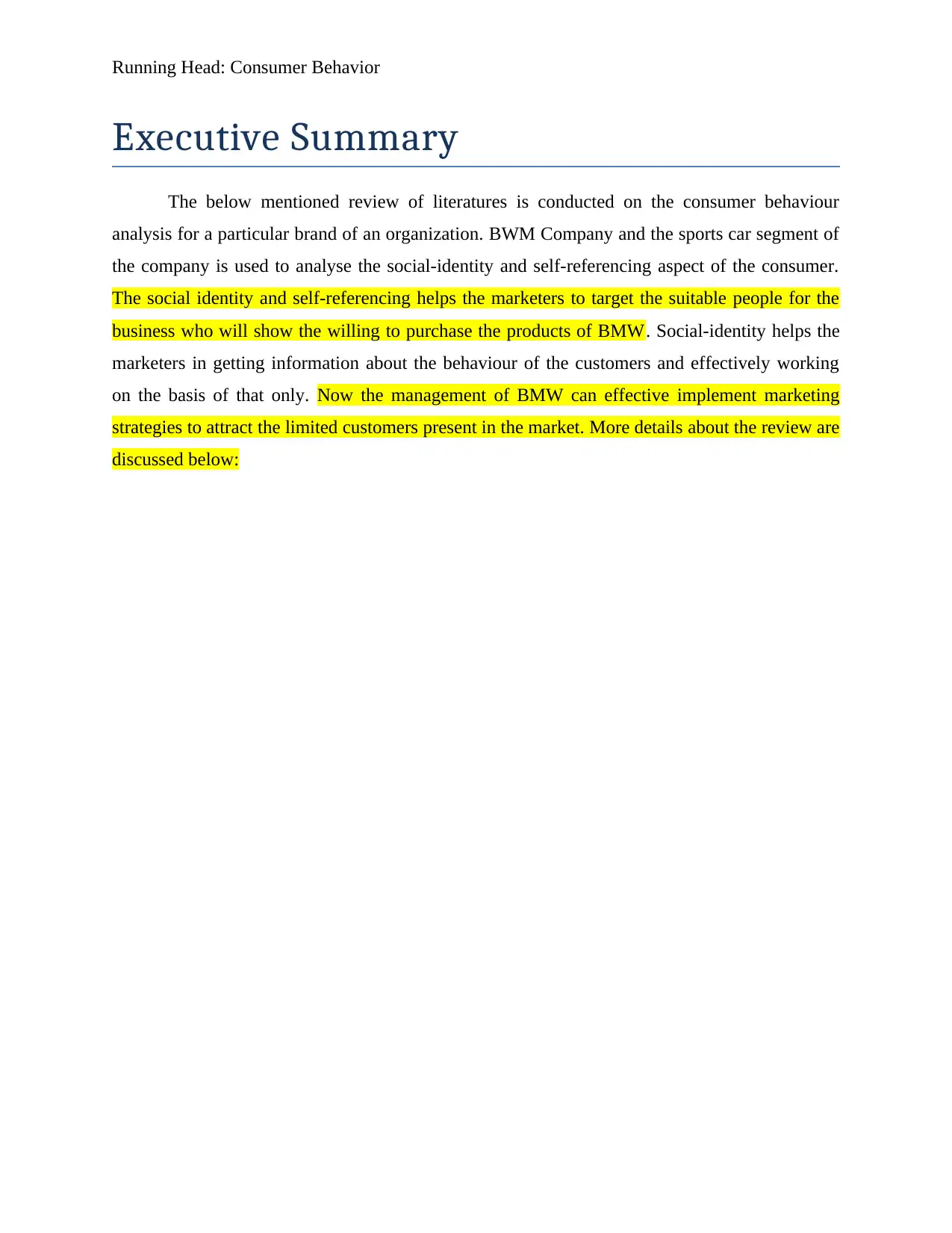
Running Head: Consumer Behavior
Executive Summary
The below mentioned review of literatures is conducted on the consumer behaviour
analysis for a particular brand of an organization. BWM Company and the sports car segment of
the company is used to analyse the social-identity and self-referencing aspect of the consumer.
The social identity and self-referencing helps the marketers to target the suitable people for the
business who will show the willing to purchase the products of BMW. Social-identity helps the
marketers in getting information about the behaviour of the customers and effectively working
on the basis of that only. Now the management of BMW can effective implement marketing
strategies to attract the limited customers present in the market. More details about the review are
discussed below:
Executive Summary
The below mentioned review of literatures is conducted on the consumer behaviour
analysis for a particular brand of an organization. BWM Company and the sports car segment of
the company is used to analyse the social-identity and self-referencing aspect of the consumer.
The social identity and self-referencing helps the marketers to target the suitable people for the
business who will show the willing to purchase the products of BMW. Social-identity helps the
marketers in getting information about the behaviour of the customers and effectively working
on the basis of that only. Now the management of BMW can effective implement marketing
strategies to attract the limited customers present in the market. More details about the review are
discussed below:
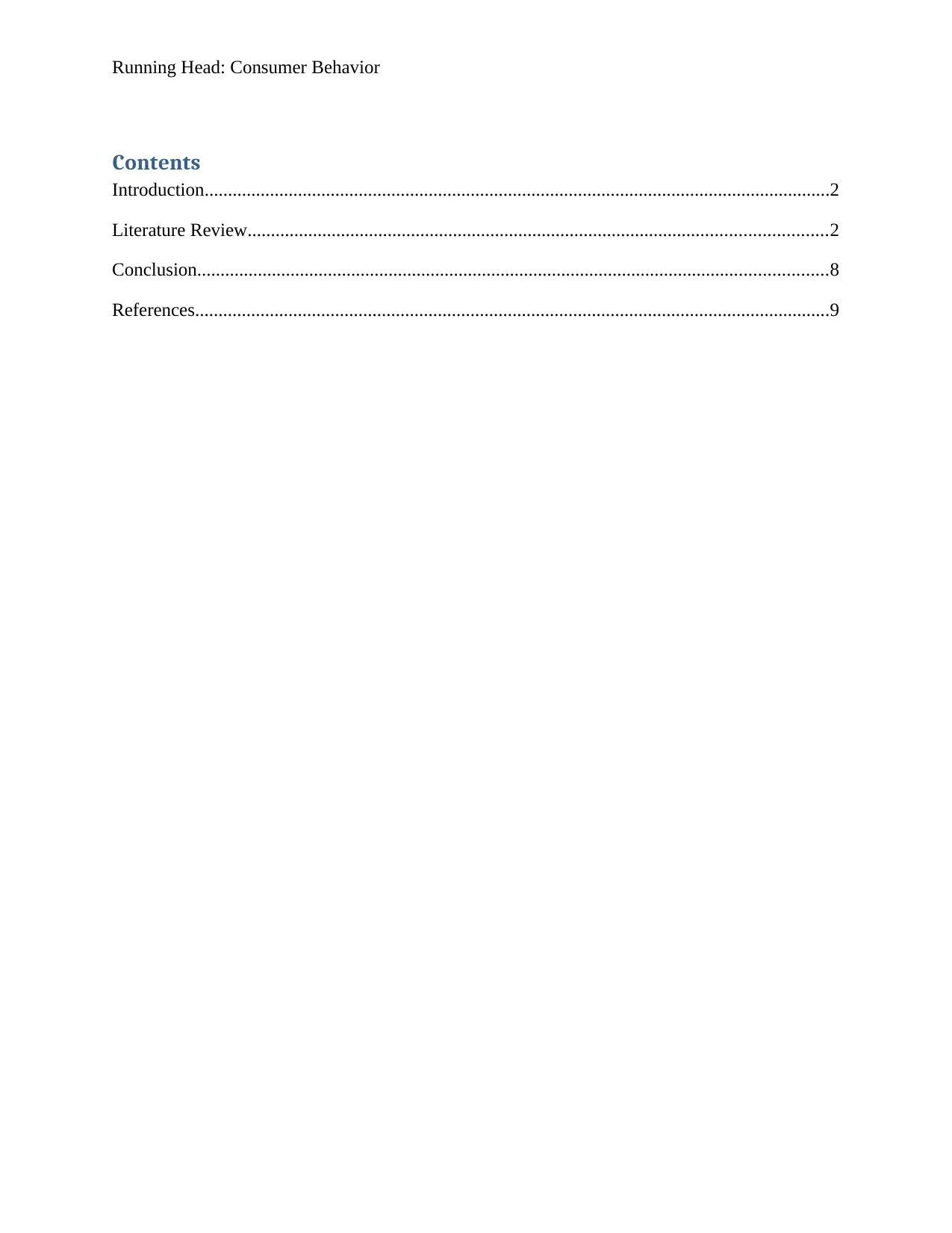
Running Head: Consumer Behavior
Contents
Introduction......................................................................................................................................2
Literature Review............................................................................................................................2
Conclusion.......................................................................................................................................8
References........................................................................................................................................9
Contents
Introduction......................................................................................................................................2
Literature Review............................................................................................................................2
Conclusion.......................................................................................................................................8
References........................................................................................................................................9
⊘ This is a preview!⊘
Do you want full access?
Subscribe today to unlock all pages.

Trusted by 1+ million students worldwide
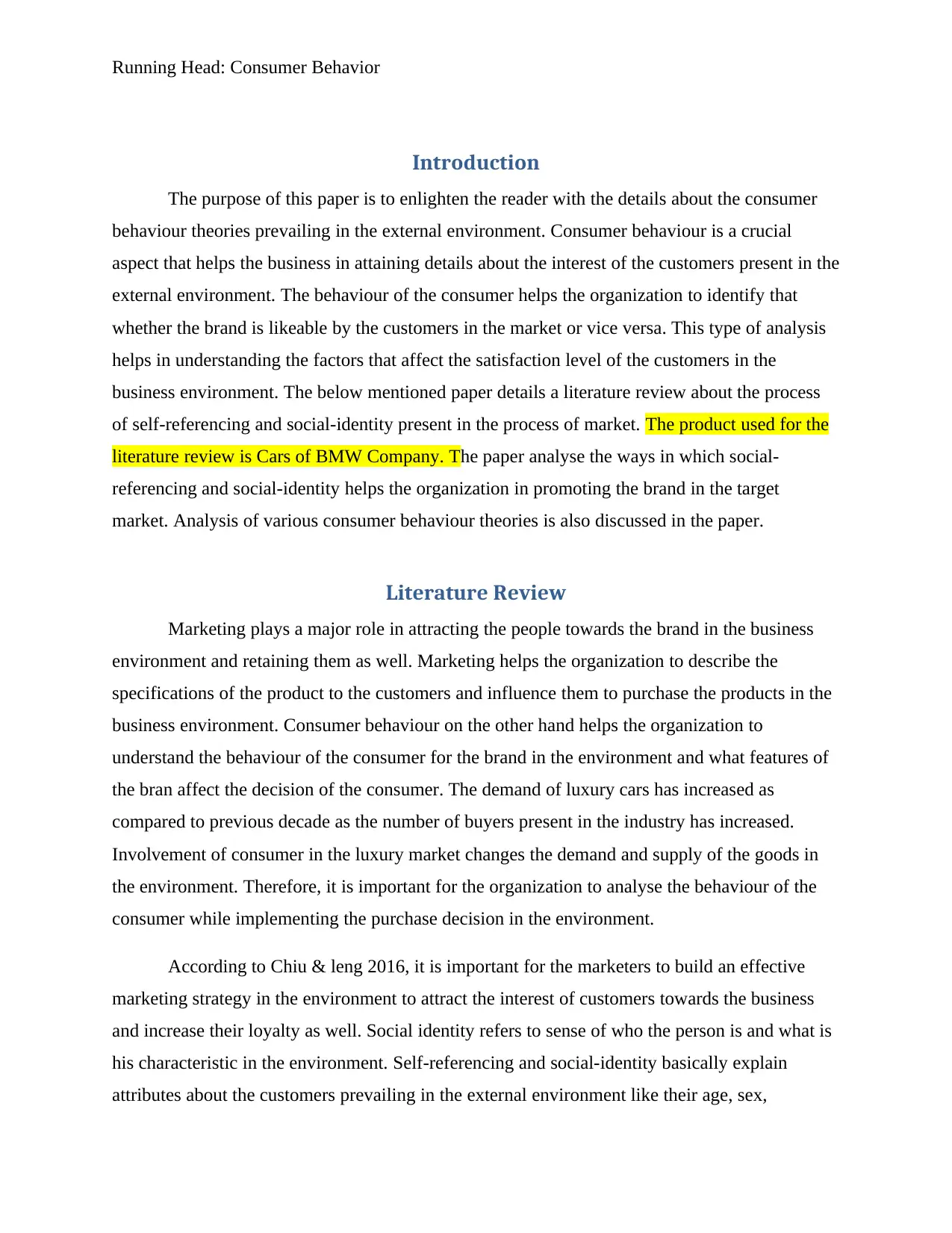
Running Head: Consumer Behavior
Introduction
The purpose of this paper is to enlighten the reader with the details about the consumer
behaviour theories prevailing in the external environment. Consumer behaviour is a crucial
aspect that helps the business in attaining details about the interest of the customers present in the
external environment. The behaviour of the consumer helps the organization to identify that
whether the brand is likeable by the customers in the market or vice versa. This type of analysis
helps in understanding the factors that affect the satisfaction level of the customers in the
business environment. The below mentioned paper details a literature review about the process
of self-referencing and social-identity present in the process of market. The product used for the
literature review is Cars of BMW Company. The paper analyse the ways in which social-
referencing and social-identity helps the organization in promoting the brand in the target
market. Analysis of various consumer behaviour theories is also discussed in the paper.
Literature Review
Marketing plays a major role in attracting the people towards the brand in the business
environment and retaining them as well. Marketing helps the organization to describe the
specifications of the product to the customers and influence them to purchase the products in the
business environment. Consumer behaviour on the other hand helps the organization to
understand the behaviour of the consumer for the brand in the environment and what features of
the bran affect the decision of the consumer. The demand of luxury cars has increased as
compared to previous decade as the number of buyers present in the industry has increased.
Involvement of consumer in the luxury market changes the demand and supply of the goods in
the environment. Therefore, it is important for the organization to analyse the behaviour of the
consumer while implementing the purchase decision in the environment.
According to Chiu & leng 2016, it is important for the marketers to build an effective
marketing strategy in the environment to attract the interest of customers towards the business
and increase their loyalty as well. Social identity refers to sense of who the person is and what is
his characteristic in the environment. Self-referencing and social-identity basically explain
attributes about the customers prevailing in the external environment like their age, sex,
Introduction
The purpose of this paper is to enlighten the reader with the details about the consumer
behaviour theories prevailing in the external environment. Consumer behaviour is a crucial
aspect that helps the business in attaining details about the interest of the customers present in the
external environment. The behaviour of the consumer helps the organization to identify that
whether the brand is likeable by the customers in the market or vice versa. This type of analysis
helps in understanding the factors that affect the satisfaction level of the customers in the
business environment. The below mentioned paper details a literature review about the process
of self-referencing and social-identity present in the process of market. The product used for the
literature review is Cars of BMW Company. The paper analyse the ways in which social-
referencing and social-identity helps the organization in promoting the brand in the target
market. Analysis of various consumer behaviour theories is also discussed in the paper.
Literature Review
Marketing plays a major role in attracting the people towards the brand in the business
environment and retaining them as well. Marketing helps the organization to describe the
specifications of the product to the customers and influence them to purchase the products in the
business environment. Consumer behaviour on the other hand helps the organization to
understand the behaviour of the consumer for the brand in the environment and what features of
the bran affect the decision of the consumer. The demand of luxury cars has increased as
compared to previous decade as the number of buyers present in the industry has increased.
Involvement of consumer in the luxury market changes the demand and supply of the goods in
the environment. Therefore, it is important for the organization to analyse the behaviour of the
consumer while implementing the purchase decision in the environment.
According to Chiu & leng 2016, it is important for the marketers to build an effective
marketing strategy in the environment to attract the interest of customers towards the business
and increase their loyalty as well. Social identity refers to sense of who the person is and what is
his characteristic in the environment. Self-referencing and social-identity basically explain
attributes about the customers prevailing in the external environment like their age, sex,
Paraphrase This Document
Need a fresh take? Get an instant paraphrase of this document with our AI Paraphraser
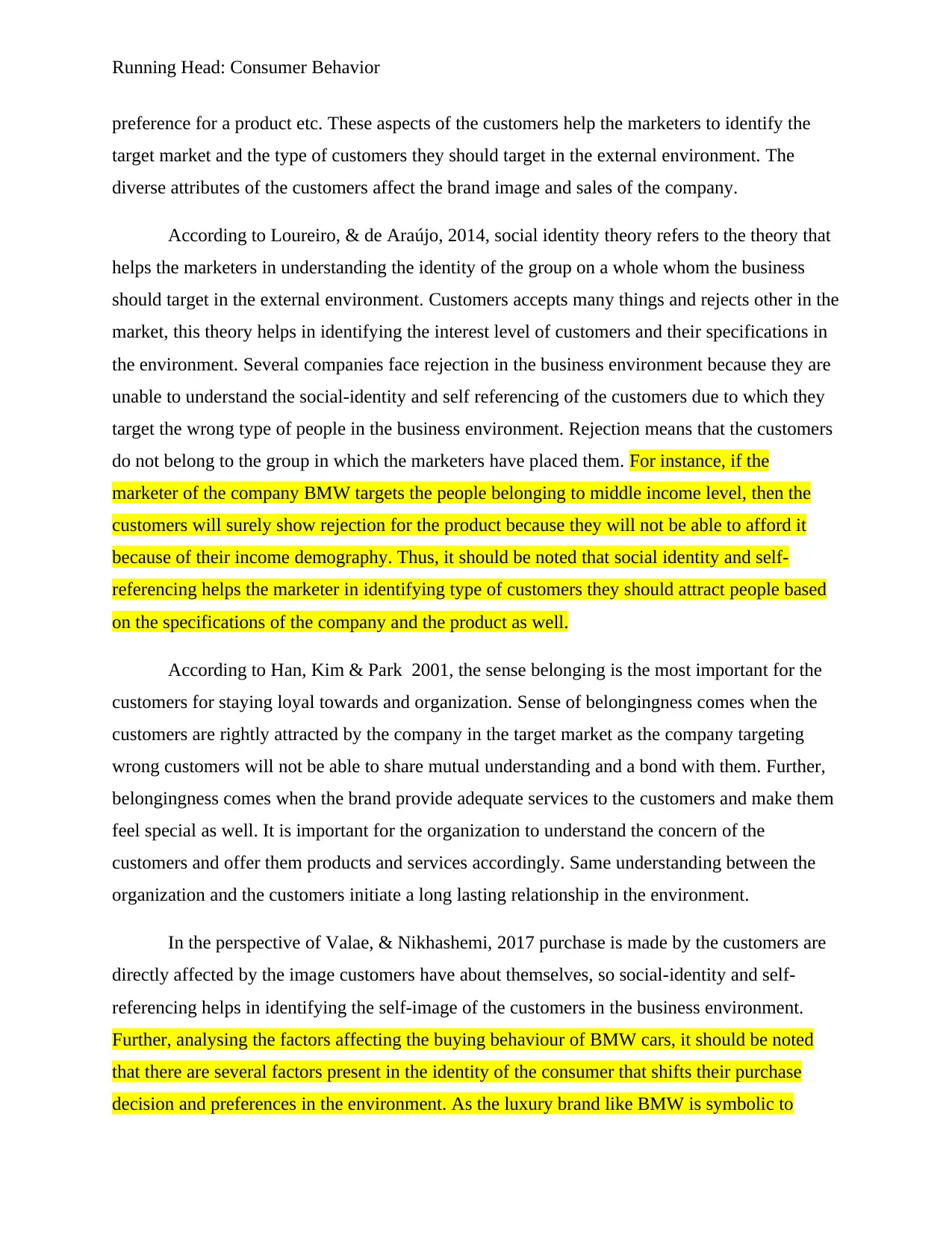
Running Head: Consumer Behavior
preference for a product etc. These aspects of the customers help the marketers to identify the
target market and the type of customers they should target in the external environment. The
diverse attributes of the customers affect the brand image and sales of the company.
According to Loureiro, & de Araújo, 2014, social identity theory refers to the theory that
helps the marketers in understanding the identity of the group on a whole whom the business
should target in the external environment. Customers accepts many things and rejects other in the
market, this theory helps in identifying the interest level of customers and their specifications in
the environment. Several companies face rejection in the business environment because they are
unable to understand the social-identity and self referencing of the customers due to which they
target the wrong type of people in the business environment. Rejection means that the customers
do not belong to the group in which the marketers have placed them. For instance, if the
marketer of the company BMW targets the people belonging to middle income level, then the
customers will surely show rejection for the product because they will not be able to afford it
because of their income demography. Thus, it should be noted that social identity and self-
referencing helps the marketer in identifying type of customers they should attract people based
on the specifications of the company and the product as well.
According to Han, Kim & Park 2001, the sense belonging is the most important for the
customers for staying loyal towards and organization. Sense of belongingness comes when the
customers are rightly attracted by the company in the target market as the company targeting
wrong customers will not be able to share mutual understanding and a bond with them. Further,
belongingness comes when the brand provide adequate services to the customers and make them
feel special as well. It is important for the organization to understand the concern of the
customers and offer them products and services accordingly. Same understanding between the
organization and the customers initiate a long lasting relationship in the environment.
In the perspective of Valae, & Nikhashemi, 2017 purchase is made by the customers are
directly affected by the image customers have about themselves, so social-identity and self-
referencing helps in identifying the self-image of the customers in the business environment.
Further, analysing the factors affecting the buying behaviour of BMW cars, it should be noted
that there are several factors present in the identity of the consumer that shifts their purchase
decision and preferences in the environment. As the luxury brand like BMW is symbolic to
preference for a product etc. These aspects of the customers help the marketers to identify the
target market and the type of customers they should target in the external environment. The
diverse attributes of the customers affect the brand image and sales of the company.
According to Loureiro, & de Araújo, 2014, social identity theory refers to the theory that
helps the marketers in understanding the identity of the group on a whole whom the business
should target in the external environment. Customers accepts many things and rejects other in the
market, this theory helps in identifying the interest level of customers and their specifications in
the environment. Several companies face rejection in the business environment because they are
unable to understand the social-identity and self referencing of the customers due to which they
target the wrong type of people in the business environment. Rejection means that the customers
do not belong to the group in which the marketers have placed them. For instance, if the
marketer of the company BMW targets the people belonging to middle income level, then the
customers will surely show rejection for the product because they will not be able to afford it
because of their income demography. Thus, it should be noted that social identity and self-
referencing helps the marketer in identifying type of customers they should attract people based
on the specifications of the company and the product as well.
According to Han, Kim & Park 2001, the sense belonging is the most important for the
customers for staying loyal towards and organization. Sense of belongingness comes when the
customers are rightly attracted by the company in the target market as the company targeting
wrong customers will not be able to share mutual understanding and a bond with them. Further,
belongingness comes when the brand provide adequate services to the customers and make them
feel special as well. It is important for the organization to understand the concern of the
customers and offer them products and services accordingly. Same understanding between the
organization and the customers initiate a long lasting relationship in the environment.
In the perspective of Valae, & Nikhashemi, 2017 purchase is made by the customers are
directly affected by the image customers have about themselves, so social-identity and self-
referencing helps in identifying the self-image of the customers in the business environment.
Further, analysing the factors affecting the buying behaviour of BMW cars, it should be noted
that there are several factors present in the identity of the consumer that shifts their purchase
decision and preferences in the environment. As the luxury brand like BMW is symbolic to

Running Head: Consumer Behavior
uniqueness, fashion, style and individuality in the environment, so the company needs to target
people possessing similar features in the external environment. The company should target
people based on their specifications and characteristics possessed in the environment (Godey, et.
al., 2016). Further, there are three types of people present in the environment whom the business
should target in the overall market, these three types of people are functional, rewarding and
indulgence. Functional are people whom the business should target in the market because they
look the specification of the cars like its body, speed etc. These are the people who purchase the
products in the environment for its long term use and become a loyal partner of the company.
These people make logical decision in the environment rather than emotional and mainly focus
on the quality of the product in the market. Secondly, rewarding refers to the segment that
involves younger people present in the target market (Eom, Seock, & Hunt-Hurst, 2019).
This group of people include a show-off personality in their nature. These types of people
will purchase BMW cars in the market just because they want to maintain their status in the
environment. They do not care about the specifications of the product until and unless it has a
premium brand image in the external market. So, it can be said that the decision is made by this
group of people while considering emotional factors rather than logical factors prevailing in the
business environment (Ashley, & Tuten, 2015). The third type of group is indulgence, these
people are the young people present in the society. This group is smallest in numbers and is male
dominated. These types of people are ready to pay premium price of the luxury goods in order
achieve the sense of individuality. These people can afford premium priced goods in the
environment and do not focus on the value derived from the product while purchasing it.
In the perspective of Pan, Lu, Wang, & Chau, 2017, it should be noted that these are the
three types of customer segments for the BMW sports car range. The factors identified from the
following analysis that affect the purchasing decision of people are visual impact, reliability,
status, quality, prestige, durability, comfort, safety, style, security, performance, value and
technology. These are the factors present in social-identity and self-referencing behaviour of a
people that affects the purchase decision of a person in the environment. Further, according to
Tajfel 2010, the ego and self-esteem of an individual is affected by their participation in social
events. The concept of social-identity examines the awareness of a person of belonging to a
particular social group prevailing in the environment due to their economic or emotional factors.
uniqueness, fashion, style and individuality in the environment, so the company needs to target
people possessing similar features in the external environment. The company should target
people based on their specifications and characteristics possessed in the environment (Godey, et.
al., 2016). Further, there are three types of people present in the environment whom the business
should target in the overall market, these three types of people are functional, rewarding and
indulgence. Functional are people whom the business should target in the market because they
look the specification of the cars like its body, speed etc. These are the people who purchase the
products in the environment for its long term use and become a loyal partner of the company.
These people make logical decision in the environment rather than emotional and mainly focus
on the quality of the product in the market. Secondly, rewarding refers to the segment that
involves younger people present in the target market (Eom, Seock, & Hunt-Hurst, 2019).
This group of people include a show-off personality in their nature. These types of people
will purchase BMW cars in the market just because they want to maintain their status in the
environment. They do not care about the specifications of the product until and unless it has a
premium brand image in the external market. So, it can be said that the decision is made by this
group of people while considering emotional factors rather than logical factors prevailing in the
business environment (Ashley, & Tuten, 2015). The third type of group is indulgence, these
people are the young people present in the society. This group is smallest in numbers and is male
dominated. These types of people are ready to pay premium price of the luxury goods in order
achieve the sense of individuality. These people can afford premium priced goods in the
environment and do not focus on the value derived from the product while purchasing it.
In the perspective of Pan, Lu, Wang, & Chau, 2017, it should be noted that these are the
three types of customer segments for the BMW sports car range. The factors identified from the
following analysis that affect the purchasing decision of people are visual impact, reliability,
status, quality, prestige, durability, comfort, safety, style, security, performance, value and
technology. These are the factors present in social-identity and self-referencing behaviour of a
people that affects the purchase decision of a person in the environment. Further, according to
Tajfel 2010, the ego and self-esteem of an individual is affected by their participation in social
events. The concept of social-identity examines the awareness of a person of belonging to a
particular social group prevailing in the environment due to their economic or emotional factors.
⊘ This is a preview!⊘
Do you want full access?
Subscribe today to unlock all pages.

Trusted by 1+ million students worldwide
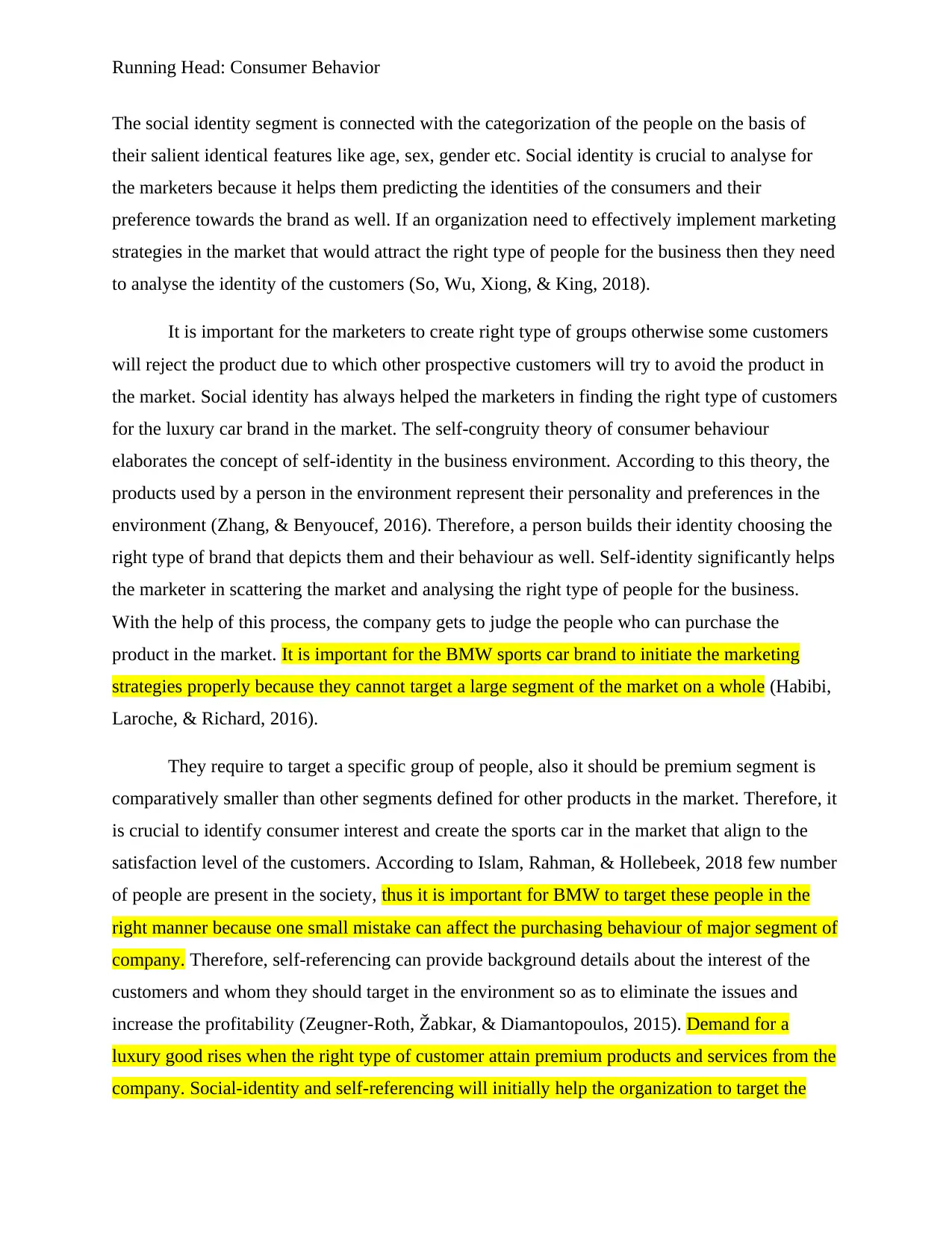
Running Head: Consumer Behavior
The social identity segment is connected with the categorization of the people on the basis of
their salient identical features like age, sex, gender etc. Social identity is crucial to analyse for
the marketers because it helps them predicting the identities of the consumers and their
preference towards the brand as well. If an organization need to effectively implement marketing
strategies in the market that would attract the right type of people for the business then they need
to analyse the identity of the customers (So, Wu, Xiong, & King, 2018).
It is important for the marketers to create right type of groups otherwise some customers
will reject the product due to which other prospective customers will try to avoid the product in
the market. Social identity has always helped the marketers in finding the right type of customers
for the luxury car brand in the market. The self-congruity theory of consumer behaviour
elaborates the concept of self-identity in the business environment. According to this theory, the
products used by a person in the environment represent their personality and preferences in the
environment (Zhang, & Benyoucef, 2016). Therefore, a person builds their identity choosing the
right type of brand that depicts them and their behaviour as well. Self-identity significantly helps
the marketer in scattering the market and analysing the right type of people for the business.
With the help of this process, the company gets to judge the people who can purchase the
product in the market. It is important for the BMW sports car brand to initiate the marketing
strategies properly because they cannot target a large segment of the market on a whole (Habibi,
Laroche, & Richard, 2016).
They require to target a specific group of people, also it should be premium segment is
comparatively smaller than other segments defined for other products in the market. Therefore, it
is crucial to identify consumer interest and create the sports car in the market that align to the
satisfaction level of the customers. According to Islam, Rahman, & Hollebeek, 2018 few number
of people are present in the society, thus it is important for BMW to target these people in the
right manner because one small mistake can affect the purchasing behaviour of major segment of
company. Therefore, self-referencing can provide background details about the interest of the
customers and whom they should target in the environment so as to eliminate the issues and
increase the profitability (Zeugner-Roth, Žabkar, & Diamantopoulos, 2015). Demand for a
luxury good rises when the right type of customer attain premium products and services from the
company. Social-identity and self-referencing will initially help the organization to target the
The social identity segment is connected with the categorization of the people on the basis of
their salient identical features like age, sex, gender etc. Social identity is crucial to analyse for
the marketers because it helps them predicting the identities of the consumers and their
preference towards the brand as well. If an organization need to effectively implement marketing
strategies in the market that would attract the right type of people for the business then they need
to analyse the identity of the customers (So, Wu, Xiong, & King, 2018).
It is important for the marketers to create right type of groups otherwise some customers
will reject the product due to which other prospective customers will try to avoid the product in
the market. Social identity has always helped the marketers in finding the right type of customers
for the luxury car brand in the market. The self-congruity theory of consumer behaviour
elaborates the concept of self-identity in the business environment. According to this theory, the
products used by a person in the environment represent their personality and preferences in the
environment (Zhang, & Benyoucef, 2016). Therefore, a person builds their identity choosing the
right type of brand that depicts them and their behaviour as well. Self-identity significantly helps
the marketer in scattering the market and analysing the right type of people for the business.
With the help of this process, the company gets to judge the people who can purchase the
product in the market. It is important for the BMW sports car brand to initiate the marketing
strategies properly because they cannot target a large segment of the market on a whole (Habibi,
Laroche, & Richard, 2016).
They require to target a specific group of people, also it should be premium segment is
comparatively smaller than other segments defined for other products in the market. Therefore, it
is crucial to identify consumer interest and create the sports car in the market that align to the
satisfaction level of the customers. According to Islam, Rahman, & Hollebeek, 2018 few number
of people are present in the society, thus it is important for BMW to target these people in the
right manner because one small mistake can affect the purchasing behaviour of major segment of
company. Therefore, self-referencing can provide background details about the interest of the
customers and whom they should target in the environment so as to eliminate the issues and
increase the profitability (Zeugner-Roth, Žabkar, & Diamantopoulos, 2015). Demand for a
luxury good rises when the right type of customer attain premium products and services from the
company. Social-identity and self-referencing will initially help the organization to target the
Paraphrase This Document
Need a fresh take? Get an instant paraphrase of this document with our AI Paraphraser
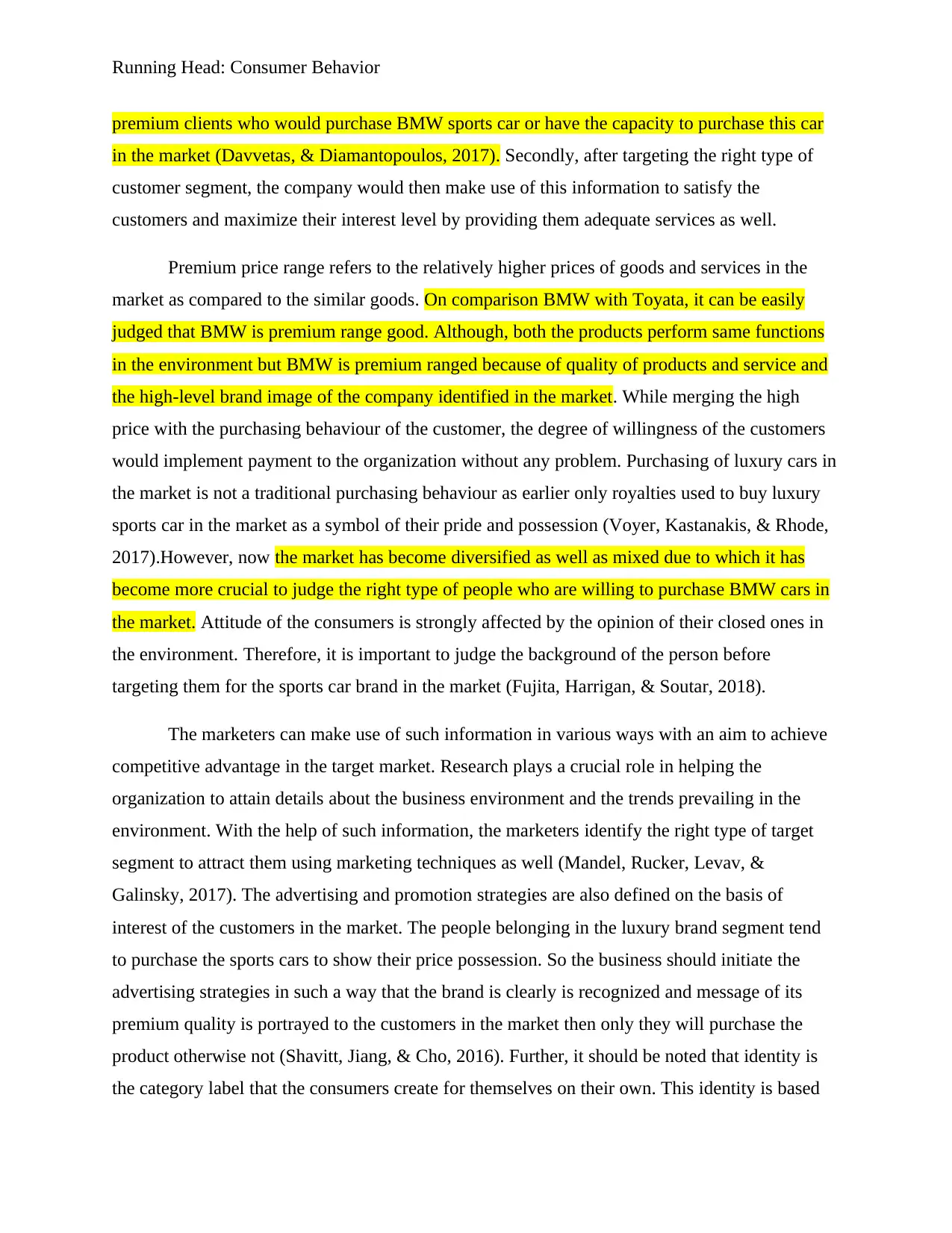
Running Head: Consumer Behavior
premium clients who would purchase BMW sports car or have the capacity to purchase this car
in the market (Davvetas, & Diamantopoulos, 2017). Secondly, after targeting the right type of
customer segment, the company would then make use of this information to satisfy the
customers and maximize their interest level by providing them adequate services as well.
Premium price range refers to the relatively higher prices of goods and services in the
market as compared to the similar goods. On comparison BMW with Toyata, it can be easily
judged that BMW is premium range good. Although, both the products perform same functions
in the environment but BMW is premium ranged because of quality of products and service and
the high-level brand image of the company identified in the market. While merging the high
price with the purchasing behaviour of the customer, the degree of willingness of the customers
would implement payment to the organization without any problem. Purchasing of luxury cars in
the market is not a traditional purchasing behaviour as earlier only royalties used to buy luxury
sports car in the market as a symbol of their pride and possession (Voyer, Kastanakis, & Rhode,
2017).However, now the market has become diversified as well as mixed due to which it has
become more crucial to judge the right type of people who are willing to purchase BMW cars in
the market. Attitude of the consumers is strongly affected by the opinion of their closed ones in
the environment. Therefore, it is important to judge the background of the person before
targeting them for the sports car brand in the market (Fujita, Harrigan, & Soutar, 2018).
The marketers can make use of such information in various ways with an aim to achieve
competitive advantage in the target market. Research plays a crucial role in helping the
organization to attain details about the business environment and the trends prevailing in the
environment. With the help of such information, the marketers identify the right type of target
segment to attract them using marketing techniques as well (Mandel, Rucker, Levav, &
Galinsky, 2017). The advertising and promotion strategies are also defined on the basis of
interest of the customers in the market. The people belonging in the luxury brand segment tend
to purchase the sports cars to show their price possession. So the business should initiate the
advertising strategies in such a way that the brand is clearly is recognized and message of its
premium quality is portrayed to the customers in the market then only they will purchase the
product otherwise not (Shavitt, Jiang, & Cho, 2016). Further, it should be noted that identity is
the category label that the consumers create for themselves on their own. This identity is based
premium clients who would purchase BMW sports car or have the capacity to purchase this car
in the market (Davvetas, & Diamantopoulos, 2017). Secondly, after targeting the right type of
customer segment, the company would then make use of this information to satisfy the
customers and maximize their interest level by providing them adequate services as well.
Premium price range refers to the relatively higher prices of goods and services in the
market as compared to the similar goods. On comparison BMW with Toyata, it can be easily
judged that BMW is premium range good. Although, both the products perform same functions
in the environment but BMW is premium ranged because of quality of products and service and
the high-level brand image of the company identified in the market. While merging the high
price with the purchasing behaviour of the customer, the degree of willingness of the customers
would implement payment to the organization without any problem. Purchasing of luxury cars in
the market is not a traditional purchasing behaviour as earlier only royalties used to buy luxury
sports car in the market as a symbol of their pride and possession (Voyer, Kastanakis, & Rhode,
2017).However, now the market has become diversified as well as mixed due to which it has
become more crucial to judge the right type of people who are willing to purchase BMW cars in
the market. Attitude of the consumers is strongly affected by the opinion of their closed ones in
the environment. Therefore, it is important to judge the background of the person before
targeting them for the sports car brand in the market (Fujita, Harrigan, & Soutar, 2018).
The marketers can make use of such information in various ways with an aim to achieve
competitive advantage in the target market. Research plays a crucial role in helping the
organization to attain details about the business environment and the trends prevailing in the
environment. With the help of such information, the marketers identify the right type of target
segment to attract them using marketing techniques as well (Mandel, Rucker, Levav, &
Galinsky, 2017). The advertising and promotion strategies are also defined on the basis of
interest of the customers in the market. The people belonging in the luxury brand segment tend
to purchase the sports cars to show their price possession. So the business should initiate the
advertising strategies in such a way that the brand is clearly is recognized and message of its
premium quality is portrayed to the customers in the market then only they will purchase the
product otherwise not (Shavitt, Jiang, & Cho, 2016). Further, it should be noted that identity is
the category label that the consumers create for themselves on their own. This identity is based
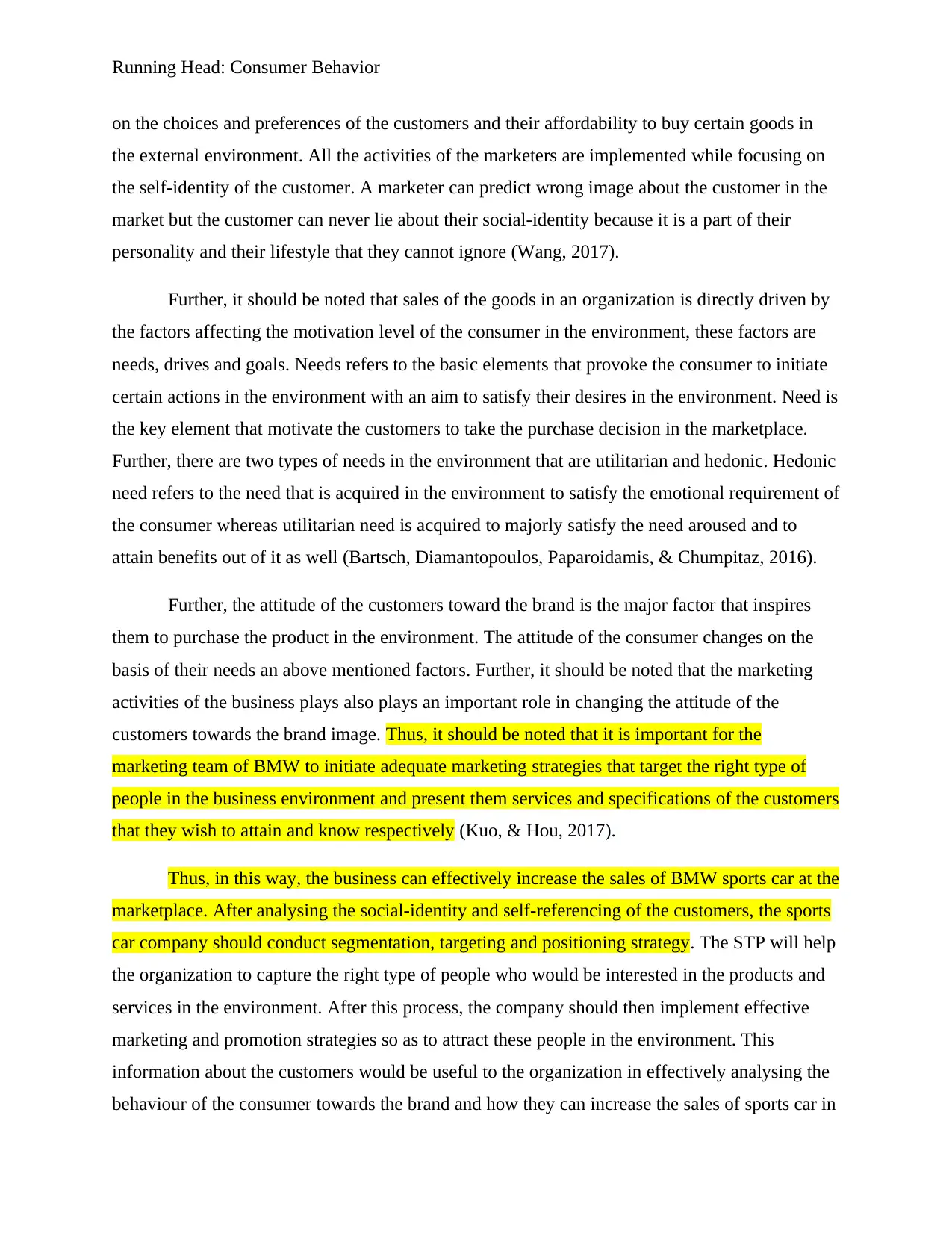
Running Head: Consumer Behavior
on the choices and preferences of the customers and their affordability to buy certain goods in
the external environment. All the activities of the marketers are implemented while focusing on
the self-identity of the customer. A marketer can predict wrong image about the customer in the
market but the customer can never lie about their social-identity because it is a part of their
personality and their lifestyle that they cannot ignore (Wang, 2017).
Further, it should be noted that sales of the goods in an organization is directly driven by
the factors affecting the motivation level of the consumer in the environment, these factors are
needs, drives and goals. Needs refers to the basic elements that provoke the consumer to initiate
certain actions in the environment with an aim to satisfy their desires in the environment. Need is
the key element that motivate the customers to take the purchase decision in the marketplace.
Further, there are two types of needs in the environment that are utilitarian and hedonic. Hedonic
need refers to the need that is acquired in the environment to satisfy the emotional requirement of
the consumer whereas utilitarian need is acquired to majorly satisfy the need aroused and to
attain benefits out of it as well (Bartsch, Diamantopoulos, Paparoidamis, & Chumpitaz, 2016).
Further, the attitude of the customers toward the brand is the major factor that inspires
them to purchase the product in the environment. The attitude of the consumer changes on the
basis of their needs an above mentioned factors. Further, it should be noted that the marketing
activities of the business plays also plays an important role in changing the attitude of the
customers towards the brand image. Thus, it should be noted that it is important for the
marketing team of BMW to initiate adequate marketing strategies that target the right type of
people in the business environment and present them services and specifications of the customers
that they wish to attain and know respectively (Kuo, & Hou, 2017).
Thus, in this way, the business can effectively increase the sales of BMW sports car at the
marketplace. After analysing the social-identity and self-referencing of the customers, the sports
car company should conduct segmentation, targeting and positioning strategy. The STP will help
the organization to capture the right type of people who would be interested in the products and
services in the environment. After this process, the company should then implement effective
marketing and promotion strategies so as to attract these people in the environment. This
information about the customers would be useful to the organization in effectively analysing the
behaviour of the consumer towards the brand and how they can increase the sales of sports car in
on the choices and preferences of the customers and their affordability to buy certain goods in
the external environment. All the activities of the marketers are implemented while focusing on
the self-identity of the customer. A marketer can predict wrong image about the customer in the
market but the customer can never lie about their social-identity because it is a part of their
personality and their lifestyle that they cannot ignore (Wang, 2017).
Further, it should be noted that sales of the goods in an organization is directly driven by
the factors affecting the motivation level of the consumer in the environment, these factors are
needs, drives and goals. Needs refers to the basic elements that provoke the consumer to initiate
certain actions in the environment with an aim to satisfy their desires in the environment. Need is
the key element that motivate the customers to take the purchase decision in the marketplace.
Further, there are two types of needs in the environment that are utilitarian and hedonic. Hedonic
need refers to the need that is acquired in the environment to satisfy the emotional requirement of
the consumer whereas utilitarian need is acquired to majorly satisfy the need aroused and to
attain benefits out of it as well (Bartsch, Diamantopoulos, Paparoidamis, & Chumpitaz, 2016).
Further, the attitude of the customers toward the brand is the major factor that inspires
them to purchase the product in the environment. The attitude of the consumer changes on the
basis of their needs an above mentioned factors. Further, it should be noted that the marketing
activities of the business plays also plays an important role in changing the attitude of the
customers towards the brand image. Thus, it should be noted that it is important for the
marketing team of BMW to initiate adequate marketing strategies that target the right type of
people in the business environment and present them services and specifications of the customers
that they wish to attain and know respectively (Kuo, & Hou, 2017).
Thus, in this way, the business can effectively increase the sales of BMW sports car at the
marketplace. After analysing the social-identity and self-referencing of the customers, the sports
car company should conduct segmentation, targeting and positioning strategy. The STP will help
the organization to capture the right type of people who would be interested in the products and
services in the environment. After this process, the company should then implement effective
marketing and promotion strategies so as to attract these people in the environment. This
information about the customers would be useful to the organization in effectively analysing the
behaviour of the consumer towards the brand and how they can increase the sales of sports car in
⊘ This is a preview!⊘
Do you want full access?
Subscribe today to unlock all pages.

Trusted by 1+ million students worldwide
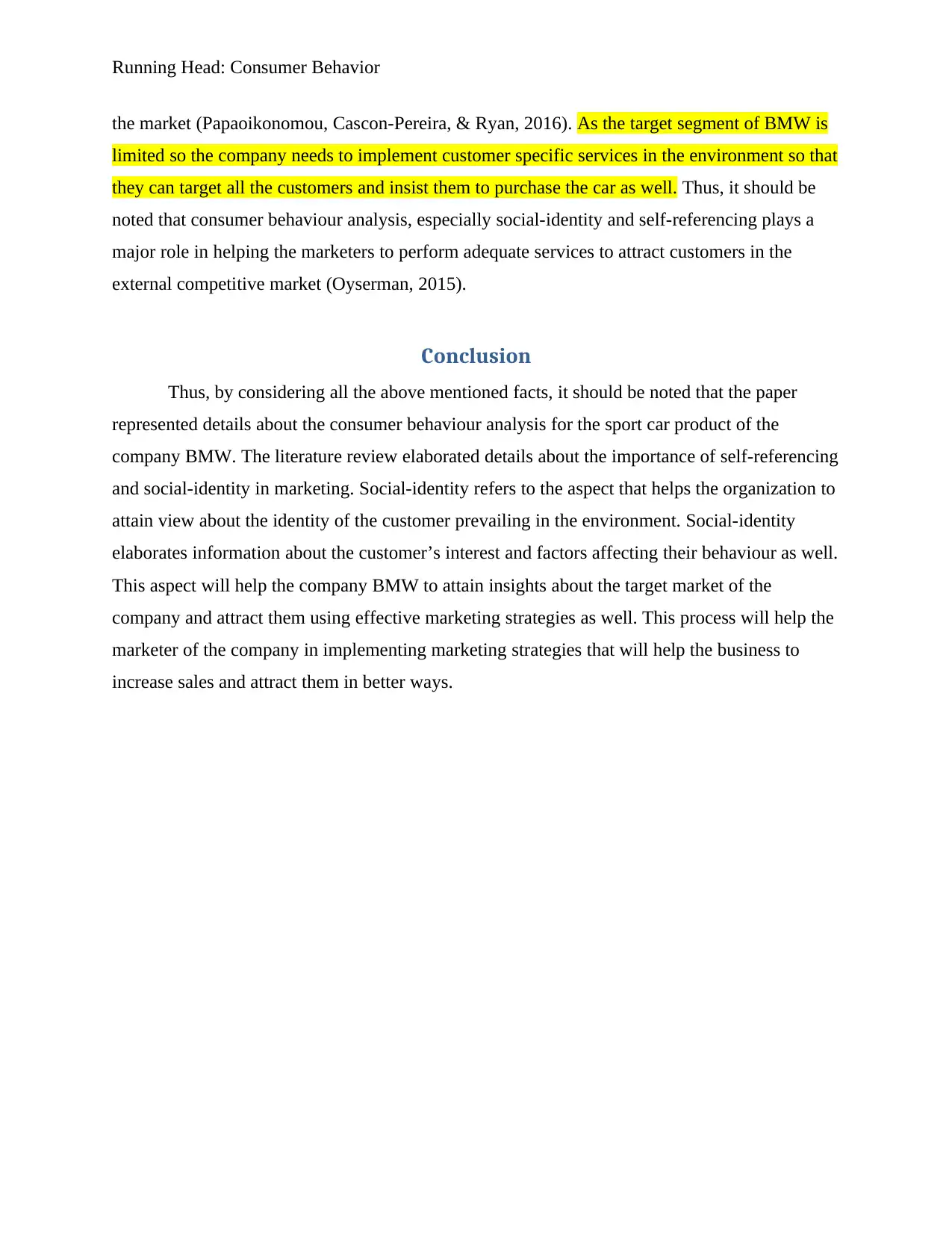
Running Head: Consumer Behavior
the market (Papaoikonomou, Cascon-Pereira, & Ryan, 2016). As the target segment of BMW is
limited so the company needs to implement customer specific services in the environment so that
they can target all the customers and insist them to purchase the car as well. Thus, it should be
noted that consumer behaviour analysis, especially social-identity and self-referencing plays a
major role in helping the marketers to perform adequate services to attract customers in the
external competitive market (Oyserman, 2015).
Conclusion
Thus, by considering all the above mentioned facts, it should be noted that the paper
represented details about the consumer behaviour analysis for the sport car product of the
company BMW. The literature review elaborated details about the importance of self-referencing
and social-identity in marketing. Social-identity refers to the aspect that helps the organization to
attain view about the identity of the customer prevailing in the environment. Social-identity
elaborates information about the customer’s interest and factors affecting their behaviour as well.
This aspect will help the company BMW to attain insights about the target market of the
company and attract them using effective marketing strategies as well. This process will help the
marketer of the company in implementing marketing strategies that will help the business to
increase sales and attract them in better ways.
the market (Papaoikonomou, Cascon-Pereira, & Ryan, 2016). As the target segment of BMW is
limited so the company needs to implement customer specific services in the environment so that
they can target all the customers and insist them to purchase the car as well. Thus, it should be
noted that consumer behaviour analysis, especially social-identity and self-referencing plays a
major role in helping the marketers to perform adequate services to attract customers in the
external competitive market (Oyserman, 2015).
Conclusion
Thus, by considering all the above mentioned facts, it should be noted that the paper
represented details about the consumer behaviour analysis for the sport car product of the
company BMW. The literature review elaborated details about the importance of self-referencing
and social-identity in marketing. Social-identity refers to the aspect that helps the organization to
attain view about the identity of the customer prevailing in the environment. Social-identity
elaborates information about the customer’s interest and factors affecting their behaviour as well.
This aspect will help the company BMW to attain insights about the target market of the
company and attract them using effective marketing strategies as well. This process will help the
marketer of the company in implementing marketing strategies that will help the business to
increase sales and attract them in better ways.
Paraphrase This Document
Need a fresh take? Get an instant paraphrase of this document with our AI Paraphraser
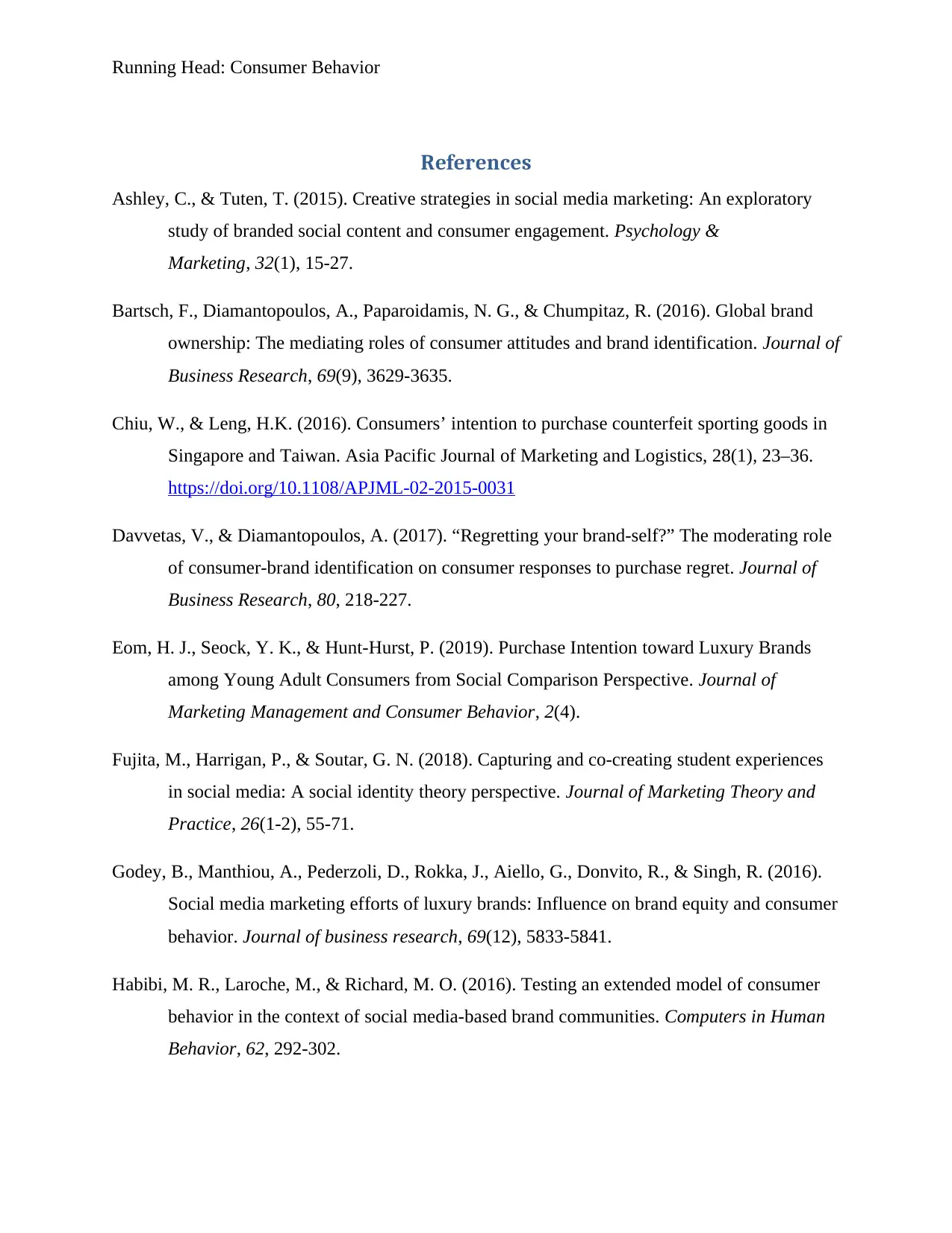
Running Head: Consumer Behavior
References
Ashley, C., & Tuten, T. (2015). Creative strategies in social media marketing: An exploratory
study of branded social content and consumer engagement. Psychology &
Marketing, 32(1), 15-27.
Bartsch, F., Diamantopoulos, A., Paparoidamis, N. G., & Chumpitaz, R. (2016). Global brand
ownership: The mediating roles of consumer attitudes and brand identification. Journal of
Business Research, 69(9), 3629-3635.
Chiu, W., & Leng, H.K. (2016). Consumers’ intention to purchase counterfeit sporting goods in
Singapore and Taiwan. Asia Pacific Journal of Marketing and Logistics, 28(1), 23–36.
https://doi.org/10.1108/APJML-02-2015-0031
Davvetas, V., & Diamantopoulos, A. (2017). “Regretting your brand-self?” The moderating role
of consumer-brand identification on consumer responses to purchase regret. Journal of
Business Research, 80, 218-227.
Eom, H. J., Seock, Y. K., & Hunt-Hurst, P. (2019). Purchase Intention toward Luxury Brands
among Young Adult Consumers from Social Comparison Perspective. Journal of
Marketing Management and Consumer Behavior, 2(4).
Fujita, M., Harrigan, P., & Soutar, G. N. (2018). Capturing and co-creating student experiences
in social media: A social identity theory perspective. Journal of Marketing Theory and
Practice, 26(1-2), 55-71.
Godey, B., Manthiou, A., Pederzoli, D., Rokka, J., Aiello, G., Donvito, R., & Singh, R. (2016).
Social media marketing efforts of luxury brands: Influence on brand equity and consumer
behavior. Journal of business research, 69(12), 5833-5841.
Habibi, M. R., Laroche, M., & Richard, M. O. (2016). Testing an extended model of consumer
behavior in the context of social media-based brand communities. Computers in Human
Behavior, 62, 292-302.
References
Ashley, C., & Tuten, T. (2015). Creative strategies in social media marketing: An exploratory
study of branded social content and consumer engagement. Psychology &
Marketing, 32(1), 15-27.
Bartsch, F., Diamantopoulos, A., Paparoidamis, N. G., & Chumpitaz, R. (2016). Global brand
ownership: The mediating roles of consumer attitudes and brand identification. Journal of
Business Research, 69(9), 3629-3635.
Chiu, W., & Leng, H.K. (2016). Consumers’ intention to purchase counterfeit sporting goods in
Singapore and Taiwan. Asia Pacific Journal of Marketing and Logistics, 28(1), 23–36.
https://doi.org/10.1108/APJML-02-2015-0031
Davvetas, V., & Diamantopoulos, A. (2017). “Regretting your brand-self?” The moderating role
of consumer-brand identification on consumer responses to purchase regret. Journal of
Business Research, 80, 218-227.
Eom, H. J., Seock, Y. K., & Hunt-Hurst, P. (2019). Purchase Intention toward Luxury Brands
among Young Adult Consumers from Social Comparison Perspective. Journal of
Marketing Management and Consumer Behavior, 2(4).
Fujita, M., Harrigan, P., & Soutar, G. N. (2018). Capturing and co-creating student experiences
in social media: A social identity theory perspective. Journal of Marketing Theory and
Practice, 26(1-2), 55-71.
Godey, B., Manthiou, A., Pederzoli, D., Rokka, J., Aiello, G., Donvito, R., & Singh, R. (2016).
Social media marketing efforts of luxury brands: Influence on brand equity and consumer
behavior. Journal of business research, 69(12), 5833-5841.
Habibi, M. R., Laroche, M., & Richard, M. O. (2016). Testing an extended model of consumer
behavior in the context of social media-based brand communities. Computers in Human
Behavior, 62, 292-302.
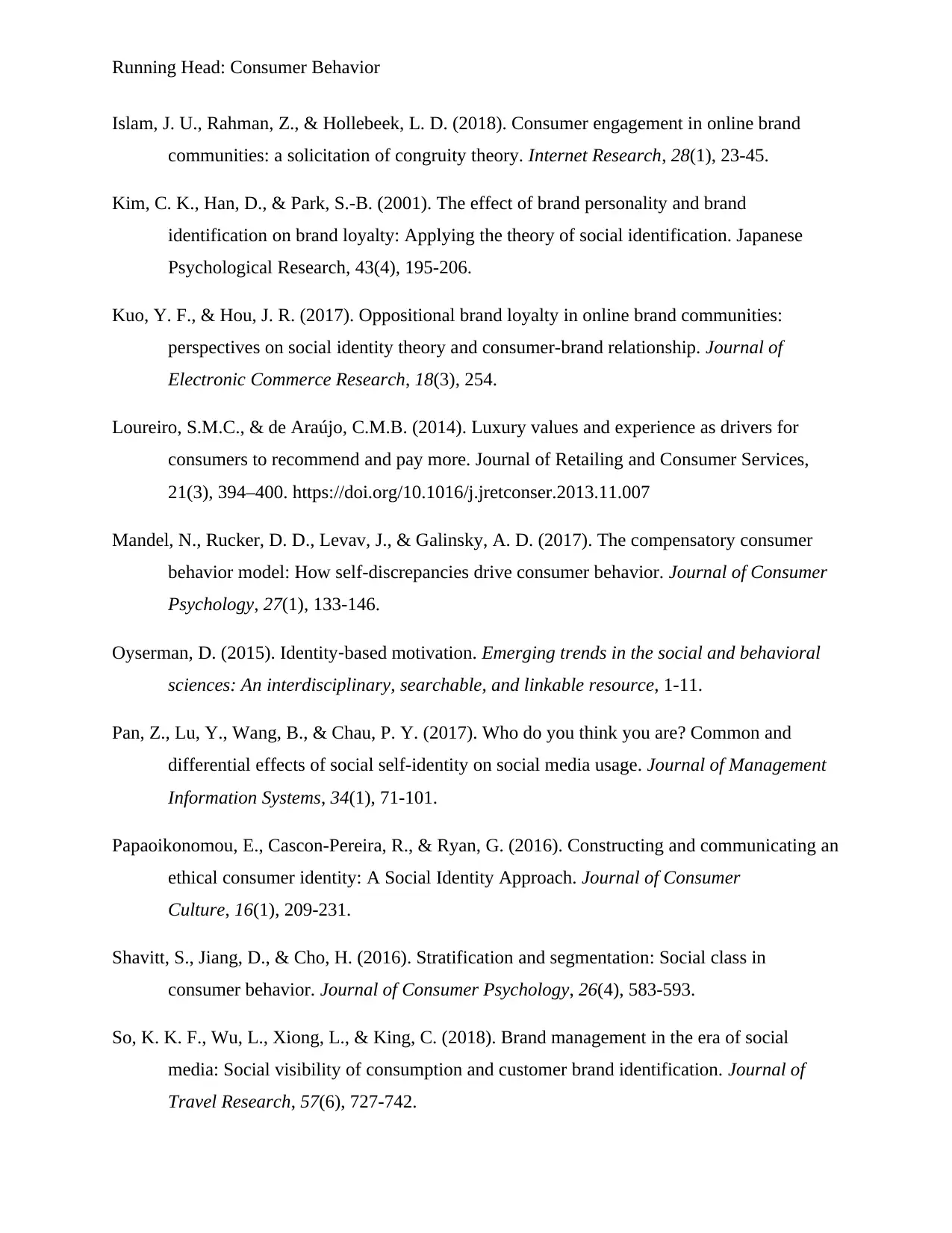
Running Head: Consumer Behavior
Islam, J. U., Rahman, Z., & Hollebeek, L. D. (2018). Consumer engagement in online brand
communities: a solicitation of congruity theory. Internet Research, 28(1), 23-45.
Kim, C. K., Han, D., & Park, S.-B. (2001). The effect of brand personality and brand
identification on brand loyalty: Applying the theory of social identification. Japanese
Psychological Research, 43(4), 195-206.
Kuo, Y. F., & Hou, J. R. (2017). Oppositional brand loyalty in online brand communities:
perspectives on social identity theory and consumer-brand relationship. Journal of
Electronic Commerce Research, 18(3), 254.
Loureiro, S.M.C., & de Araújo, C.M.B. (2014). Luxury values and experience as drivers for
consumers to recommend and pay more. Journal of Retailing and Consumer Services,
21(3), 394–400. https://doi.org/10.1016/j.jretconser.2013.11.007
Mandel, N., Rucker, D. D., Levav, J., & Galinsky, A. D. (2017). The compensatory consumer
behavior model: How self-discrepancies drive consumer behavior. Journal of Consumer
Psychology, 27(1), 133-146.
Oyserman, D. (2015). Identity‐based motivation. Emerging trends in the social and behavioral
sciences: An interdisciplinary, searchable, and linkable resource, 1-11.
Pan, Z., Lu, Y., Wang, B., & Chau, P. Y. (2017). Who do you think you are? Common and
differential effects of social self-identity on social media usage. Journal of Management
Information Systems, 34(1), 71-101.
Papaoikonomou, E., Cascon-Pereira, R., & Ryan, G. (2016). Constructing and communicating an
ethical consumer identity: A Social Identity Approach. Journal of Consumer
Culture, 16(1), 209-231.
Shavitt, S., Jiang, D., & Cho, H. (2016). Stratification and segmentation: Social class in
consumer behavior. Journal of Consumer Psychology, 26(4), 583-593.
So, K. K. F., Wu, L., Xiong, L., & King, C. (2018). Brand management in the era of social
media: Social visibility of consumption and customer brand identification. Journal of
Travel Research, 57(6), 727-742.
Islam, J. U., Rahman, Z., & Hollebeek, L. D. (2018). Consumer engagement in online brand
communities: a solicitation of congruity theory. Internet Research, 28(1), 23-45.
Kim, C. K., Han, D., & Park, S.-B. (2001). The effect of brand personality and brand
identification on brand loyalty: Applying the theory of social identification. Japanese
Psychological Research, 43(4), 195-206.
Kuo, Y. F., & Hou, J. R. (2017). Oppositional brand loyalty in online brand communities:
perspectives on social identity theory and consumer-brand relationship. Journal of
Electronic Commerce Research, 18(3), 254.
Loureiro, S.M.C., & de Araújo, C.M.B. (2014). Luxury values and experience as drivers for
consumers to recommend and pay more. Journal of Retailing and Consumer Services,
21(3), 394–400. https://doi.org/10.1016/j.jretconser.2013.11.007
Mandel, N., Rucker, D. D., Levav, J., & Galinsky, A. D. (2017). The compensatory consumer
behavior model: How self-discrepancies drive consumer behavior. Journal of Consumer
Psychology, 27(1), 133-146.
Oyserman, D. (2015). Identity‐based motivation. Emerging trends in the social and behavioral
sciences: An interdisciplinary, searchable, and linkable resource, 1-11.
Pan, Z., Lu, Y., Wang, B., & Chau, P. Y. (2017). Who do you think you are? Common and
differential effects of social self-identity on social media usage. Journal of Management
Information Systems, 34(1), 71-101.
Papaoikonomou, E., Cascon-Pereira, R., & Ryan, G. (2016). Constructing and communicating an
ethical consumer identity: A Social Identity Approach. Journal of Consumer
Culture, 16(1), 209-231.
Shavitt, S., Jiang, D., & Cho, H. (2016). Stratification and segmentation: Social class in
consumer behavior. Journal of Consumer Psychology, 26(4), 583-593.
So, K. K. F., Wu, L., Xiong, L., & King, C. (2018). Brand management in the era of social
media: Social visibility of consumption and customer brand identification. Journal of
Travel Research, 57(6), 727-742.
⊘ This is a preview!⊘
Do you want full access?
Subscribe today to unlock all pages.

Trusted by 1+ million students worldwide
1 out of 13
Related Documents
Your All-in-One AI-Powered Toolkit for Academic Success.
+13062052269
info@desklib.com
Available 24*7 on WhatsApp / Email
![[object Object]](/_next/static/media/star-bottom.7253800d.svg)
Unlock your academic potential
Copyright © 2020–2025 A2Z Services. All Rights Reserved. Developed and managed by ZUCOL.





